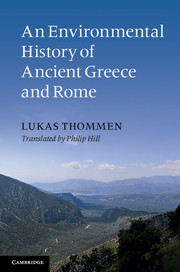Book contents
- Frontmatter
- Contents
- Figures
- Preface
- Introduction
- Part I Greece
- Chapter 1 The geographic space
- Chapter 2 People and nature
- Chapter 3 Agriculture
- Chapter 4 Forests and timber
- Chapter 5 Gardens
- Chapter 6 Animals
- Chapter 7 Food
- Chapter 8 Fire and water
- Chapter 9 Earthquakes and volcanoes
- Chapter 10 Mining
- Part II Rome
- Chronology
- Further reading
- Sources
- Bibliography
- Index
Chapter 4 - Forests and timber
Published online by Cambridge University Press: 05 June 2012
- Frontmatter
- Contents
- Figures
- Preface
- Introduction
- Part I Greece
- Chapter 1 The geographic space
- Chapter 2 People and nature
- Chapter 3 Agriculture
- Chapter 4 Forests and timber
- Chapter 5 Gardens
- Chapter 6 Animals
- Chapter 7 Food
- Chapter 8 Fire and water
- Chapter 9 Earthquakes and volcanoes
- Chapter 10 Mining
- Part II Rome
- Chronology
- Further reading
- Sources
- Bibliography
- Index
Summary
The forest cover in the Mediterranean had already been subject to significant change during the centuries before the Greek settlement. Between 5000 and 3000 bc a shift occurred in south-eastern Europe (the Balkans), with cold treeless and wooded steppes and summer-green deciduous and coniferous forests being replaced by evergreen oak-woods. An investigation of the Argolis area of the Peloponnese reveals that it was covered before the Bronze Age (i.e., prior to 3500 bc) with thick deciduous forests of downy oak; in the Bronze Age (the third and second millennia bc), by sparser woods or macchia with evergreen holm oaks and pines; and starting around 900/800 bc, by olive and walnut trees. In addition to the hardwood deciduous trees, such as oak and olive, there were also such evergreen bushes as myrtle and oleander, and, particularly in higher locations, pine and cypress (Fig. 4). Cypresses grew especially in Crete, and cedars in Syria and Phoenicia, where they were primarily felled for shipbuilding (Theophr. hist. plant. 4.1.3, 5.7.1).
In ancient Greece the forests were already a source of energy and of building materials. The available literary information refers particularly to Athens. Attica experienced a rise in population during the seventh and sixth centuries bc, which resulted in increased clearing of the wooded slopes of the nearby Aegaleus and Hymettus Mountains (Figs. 5 and 6). More remote mountains, too, such as the Parnes, Kithairon and Pentelikon ranges, were also used to obtain wood supplies. The comic dramatist Aristophanes (c. 445–386 bc) in his play The Acharnians has charcoal burners from Acharnae appear as a choir, an indication of charcoal trade from the area of the Parnes, based on oak, maple or beech. In the Kithairon Mountains, there is a pass called Dryoskephalai (‘oak heads’, Hdt. 9.39), which indicates an old stand of oak. Thucydides (2.75) reports that at the end of the fifth century bc wood was felled on Kithairon. The Pentelikon Mountains, however, were primarily noted for quarrying of marble. On the plains there were, moreover, numerous olive plantations, which were legally protected (Dem. 43.71), but probably also scattered smaller clusters of oak, fir and elm. During the Peloponnesian War the destruction carried out by the Spartans in the Attic countryside probably rather affected the olive and fruit trees more than the actual woodland with building timber.
- Type
- Chapter
- Information
- An Environmental History of Ancient Greece and Rome , pp. 37 - 41Publisher: Cambridge University PressPrint publication year: 2012



